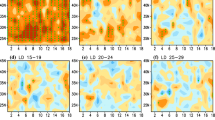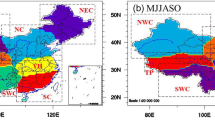Abstract
Dynamical prediction of monsoon rainfall has been an important topic and a long-standing issue in both research and operational community. This paper provides a comprehensive evaluation of the subseasonal-to-seasonal (S2S) prediction skill of the East Asian summer monsoon (EASM) rainfall using the hindcast record from the Beijing Climate Center Climate System Model, BCC CSM1.1m, during the period 1983–2019. The model exhibits reasonable skills for predicting the EASM rainfall at all lead times with the skill dropping dramatically from the shortest lead time of about 2 weeks (LM0) to 1-month lead (LM1), and then fluctuating remarkably throughout 2-month to 12-month lead times. Over the EASM domain, the rapid decline of the S2S rainfall prediction skill from LM0 to LM1 is mainly caused by the inferior skills over Central China in July and over Northeast China in August. Composite analysis based on hindcast records suggest that these inferior skills are directly tied to the model’s difficulties in capturing above-normal precipitation over eastern Central China and Northeast China in the respective months, which are further shown to be associated with anomalous weakening and meridional movement of the Northwestern Pacific subtropical high and the activity of large-scale teleconnection pattern hard to be predicted over northeastern Asia in summer, respectively. These findings inform the intrinsic limits of the S2S predictability of the EASM rainfall by a dynamical model, and strongly suggest that the level of confidence placed upon S2S forecasts should be stratified by large-scale circulation anomalies known to significantly affect the prediction skill, e.g., the subtropical high and high-latitude teleconnection patterns for summer monsoon rainfall prediction in this region.











Similar content being viewed by others
References
Adler RF et al (2018) The global precipitation climatology project (GPCP) monthly analysis (new version 2.3) and a review of 2017 global precipitation. Atmosphere 9(4):138. https://doi.org/10.3390/atmos9040138
Charney JG, Shukla J (1981) Predictability of monsoons chap 6. In: Lighthill J, Pearce RP (eds) Monsoon dynamics. Cambridge University Press. https://doi.org/10.1017/CBO9780511897580.009
Cheng Y, Tang Y, Zhou X, Jackson P, Chen D (2010) Further analysis of singular vector and ENSO predictability in the Lamont model—part I: singular vector and the control factors. Clim Dyn 35:807–826. https://doi.org/10.1007/s00382-009-0595-7
de Andrade FM, Coelho CAS, Cavalcanti IFA (2019) Global precipitation hindcast quality assessment of the subseasonal to seasonal (S2S) prediction project models. Clim Dyn 52:5451–5475. https://doi.org/10.1007/s00382-018-4457-z
Dong B, Wilcox LJ, Highwood EJ, Sutton RT (2019) Impacts of recent decadal changes in Asian aerosols on the East Asian summer monsoon: roles of aerosol–radiation and aerosol-cloud interactions. Clim Dyn 53:3235–3256. https://doi.org/10.1007/s00382-019-04698-0
Fang YH et al (2018) The remote responses of early summer cold vortex precipitation in Northeastern China compared with the previous sea surface temperatures. Atmos Res 214:399–409. https://doi.org/10.1016/j.atmosres.2018.08.007
Griffies SM, Gnanadesikan A, Dixon KW, Dunne JP, Gerdes R, Harrison MJ, Rosati A, Russell JL, Samuels BL, Spelman MJ, Winton M, Zhang R (2005) Formulation of an ocean model for global climate simulations. Ocean Sci 1:45–79. https://doi.org/10.5194/os-1-45-2005
Hersbach H et al (2020) The ERA5 global reanalysis. Q J R Meteorol Soc 146:1999–2049. https://doi.org/10.1002/qj.3803
Ji J, Huang M, Li K (2008) Prediction of carbon exchange between China terrestrial ecosystem and atmosphere in 21st century. Sci China Ser D Earth Sci 51:885–898. https://doi.org/10.1007/s11430-008-0039-y
Jie W, Vitart F, Wu T, Liu X (2017) Simulations of Asian Summer Monsoon in the Sub-seasonal to Seasonal Prediction Project (S2S) database: simulations of Asian summer monsoon in the S2S database. Q J R Meteorol Soc 143:2282–2295. https://doi.org/10.1002/qj.3085
Johnson SJ et al (2019) SEAS5: the new ECMWF seasonal forecast system. Geosci Model Dev 12:1087–1117. https://doi.org/10.5194/gmd-12-1087-2019
Keane RJ et al (2019) Fast biases in monsoon rainfall over Southern and Central India in the Met Office unified model. J Clim 32:6385–6402. https://doi.org/10.1175/JCLI-D-18-0650.1
Kim HM, Webster PJ, Curry JA, Toma VE (2012) Asian summer monsoon prediction in ECMWF System 4 and NCEP CFSv2 retrospective seasonal forecasts. Clim Dyn 39:2975–2991. https://doi.org/10.1007/s00382-012-1470-5
Kitoh A et al (2013) Monsoons in a changing world: a regional perspective in a global context. J Geophys Res 118:3053–3065. https://doi.org/10.1002/jgrd.50258
Kug JS, Kang IS, Choi DH (2008) Seasonal climate predictability with tier-one and tier-two prediction systems. Clim Dyn 31:403–416. https://doi.org/10.1007/s00382-007-0264-7
Li J, Zeng Q (2002) A unified monsoon index. Geophys Res Lett. https://doi.org/10.1029/2001GL013874
Li J, Zeng Q (2003) A new monsoon index and the geographical distribution of the global monsoons. Adv Atmos Sci 20:299–302. https://doi.org/10.1007/s00376-003-0016-5
Li J, Zeng Q (2005) A new monsoon index, its interannual variability and relation with monsoon precipitation. Clim Environ Res 10(3):351–365. https://doi.org/10.3878/j.issn.1006-9585.2005.03.09 (In Chinese)
Li CF, Lu RY, Dong BW (2012) Predictability of the western North Pacific summer climate demonstrated by the coupled models of ENSEMBLES. Clim Dyn 39:329–346. https://doi.org/10.1007/s00382-011-1274-z
Li Y et al (2019) Multi-scale temporal-spatial variability of the East Asian summer monsoon frontal system: observation versus its representation in the GFDL HiRAM. Clim Dyn 52:6787–6798. https://doi.org/10.1007/s00382-018-4546-z
Li J, Wang B, Yang YM (2020) Diagnostic metrics for evaluating model simulations of the East Asian Monsoon. J Clim 33:1777–1801. https://doi.org/10.1175/JCLI-D-18-0808.1
Lian Y, Shen B, Li S, Liu G, Yang X (2016) Mechanisms for the formation of Northeast China cold vortex and its activities and impacts: an overview. J Meteorol Res 30:881–896. https://doi.org/10.1007/s13351-016-6003-4
Lin X, Li C, Lu R, Scaife AA (2018) Predictable and unpredictable components of the summer East Asia-Pacific teleconnection pattern. Adv Atmos Sci 35:1372–1380. https://doi.org/10.1007/s00376-018-7305-5
Liu Y, Ren HL (2015) A hybrid statistical downscaling model for prediction of winter precipitation in China. Int J Climatol 35(7):1309–1321. https://doi.org/10.1002/joc.4058
Liu Y, Ren HL (2017) Improving ENSO prediction in CFSv2 with an analogue-based correction method. Int J Climatol 37:5035–5046. https://doi.org/10.1002/joc.5142
Liu X et al (2014) Subseasonal forecast skills and biases of global summer monsoons in the NCEP climate forecast system version 2. Clim Dyn 42:1487–1508. https://doi.org/10.1007/s00382-013-1831-8
Liu X et al (2015) Performance of the seasonal forecasting of the Asian summer monsoon by BCC_CSM1.1(m). Adv Atmos Sci 32:1156–1172. https://doi.org/10.1007/s00376-015-4194-8
Liu Y, Ren HL, Scaife AA, Li CF (2018) Evaluation and statistical downscaling of East Asian summer monsoon forecasting in BCC and MOHC seasonal prediction systems. Q J R Meteorol Soc 144(717):2798–2811. https://doi.org/10.1002/qj.3405
Liu Y et al (2021) An operational statistical downscaling prediction model of the winter monthly temperature over China based on a multi-model ensemble. Atmos Res 249:105262. https://doi.org/10.1016/j.atmosres.2020.105262
Ma JH, Wang HJ (2014) Design and testing of a global climate prediction system based on a coupled climate model. Sci China Earth Sci 57:2417–2427. https://doi.org/10.1007/s11430-014-4875-7
Nitta T (1987) Convective activities in the tropical western Pacific and their impact on the northern hemisphere summer circulation. J Meteorol Soc Jpn 65:373–390. https://doi.org/10.2151/jmsj1965.65.3_373
Park HJ, Kryjov VN, Ahn JB (2018) One-month-lead predictability of Asian summer monsoon indices based on the zonal winds by the APCC multimodel ensemble. J Clim 31:8945–8960. https://doi.org/10.1175/JCLI-D-17-0816.1
Ramage CS (1971) Monsoon meteorology vol 15. In: Miller DH (ed) International geophysics. Academic Press
Ren HL et al (2017) Prediction of primary climate variability modes at the Beijing Climate Center. J Meteorol Res 31:204–223. https://doi.org/10.1007/s13351-017-6097-3
Saha S et al (2014) The NCEP climate forecast system version 2. J Clim 27:2185–2208. https://doi.org/10.1175/JCLI-D-12-00823.1
Shukla J (1998) Predictability in the midst of chaos: a scientific basis for climate forecasting. Science 282:728–731. https://doi.org/10.1126/science.282.5389.728
Singh B, Cash B, Kinter JL III (2019) Indian summer monsoon variability forecasts in the North American multimodel ensemble. Clim Dyn 53:7321–7334. https://doi.org/10.1007/s00382-018-4203-6
Son J-H, Seo K-H, Wang B (2019) Dynamical control of the Tibetan Plateau on the East Asian Summer Monsoon. Geophys Res Lett 46(13):7672–7679. https://doi.org/10.1029/2019GL083104
Son J-H, Seo K-H, Wang B (2020) How does the Tibetan Plateau dynamically affect downstream monsoon precipitation? Geophys Res Lett 47(23):e2020GL090543. https://doi.org/10.1029/2020GL090543
Son J-H, Seo K-H, Son S-W, Cha D-H (2021) How does Indian Monsoon regulate the northern hemisphere stationary wave pattern? Front Earth Sci 8:599745. https://doi.org/10.3389/feart.2020.599745
Sun ZB, Cao R, Ni DH (2016) A classification of summer precipitation patterns over Northeast China and their atmospheric circulation characteristics. Trans Atmos Sci 39(1):18–27. https://doi.org/10.13878/j.cnki.dqkxxb.20140415001 (In Chinese)
Trenberth KE, Stepaniak DP, Caron JM (2000) The Global monsoon as seen through the divergent atmospheric circulation. J Clim 13:3969–3993. https://doi.org/10.1175/1520-0442(2000)013%3c3969:TGMAST%3e2.0.CO;2
Tzeng RY, Lee YH (2001) The effects of land–surface characteristics on the East Asian summer monsoon. Clim Dyn 17:317–326. https://doi.org/10.1007/s003820000115
Vitart F, Robertson AW (2018) The sub-seasonal to seasonal prediction project (S2S) and the prediction of extreme events. Npj Clim Atmos Sci 1:3. https://doi.org/10.1038/s41612-018-0013-0
Wang B, Ding Q (2006) Changes in global monsoon precipitation over the past 56 years. Geophys Res Lett 33:L06711. https://doi.org/10.1029/2005GL025347
Wang B, Ho L (2002) Rainy season of the Asian-Pacific summer monsoon. J Clim 15:386–398. https://doi.org/10.1175/1520-0442(2002)015%3c0386:RSOTAP%3e2.0.CO;2
Wang B et al (2008) How to measure the strength of the East Asian summer monsoon. J Clim 21:4449–4463. https://doi.org/10.1175/2008JCLI2183.1
Wang B, Jin C, Liu J (2020a) Understanding future change of global monsoons projected by CMIP6 models. J Clim 33:6471–6489. https://doi.org/10.1175/JCLI-D-19-0993.1
Wang L, Ren HL, Zhu J, Huang B (2020b) Improving prediction of two ENSO types using a multi-model ensemble based on stepwise pattern projection model. Clim Dyn 54:3229–3243. https://doi.org/10.1007/s00382-020-05160-2
Wang Y et al (2020c) Multi-model ensemble sub-seasonal forecasting of precipitation over the maritime continent in boreal summer. Atmosphere 11:515. https://doi.org/10.3390/atmos11050515
Winton M (2000) A reformulated three-layer sea ice model. J Atmos Oceanic Technol 17:525–531. https://doi.org/10.1175/1520-0426(2000)017%3c0525:ARTLSI%3e2.0.CO;2
Wu TW et al (2010) The Beijing Climate Center atmospheric general circulation model: description and its performance for the present-day climate. Clim Dyn 34:123–147. https://doi.org/10.1007/s00382-008-0487-2
Wu TW et al (2014) An overview of BCC climate system model development and application for climate change studies. J Meteorol Res 28(1):34–56. https://doi.org/10.1007/s13351-014-3041-7
Zhou F et al (2020) Seasonal predictability of primary East-Asian summer circulation patterns by three operational climate prediction models. Q J R Meteorol Soc 146:629–646. https://doi.org/10.1002/qj.3697
Acknowledgements
This work is jointly supported by China National Key Research and Development Program on Monitoring, Early Warning and Prevention of Major Natural Disaster (2018YFC1506005), Forecaster Special Project of China Meteorological Administration (CMAYBY2020-071), Fund Project of Collaborative Innovation in Science and Technology in Bohai Sea Rim (QYXM201904) and the China Scholarship Council (award to Na Wang for 1 year’s visit abroad at the Georgia Institute of Technology). Yi Deng is in part supported by the U.S. National Science Foundation (NSF) through Grant AGS-2032532 and by the U.S. National Oceanic and Atmospheric Administration (NOAA) through Grant NA20OAR4310380.
Author information
Authors and Affiliations
Corresponding authors
Additional information
Publisher's Note
Springer Nature remains neutral with regard to jurisdictional claims in published maps and institutional affiliations.
Rights and permissions
About this article
Cite this article
Wang, N., Ren, HL., Deng, Y. et al. Understanding the causes of rapidly declining prediction skill of the East Asian summer monsoon rainfall with lead time in BCC_CSM1.1m. Clim Dyn 62, 2807–2821 (2024). https://doi.org/10.1007/s00382-021-05819-4
Received:
Accepted:
Published:
Issue Date:
DOI: https://doi.org/10.1007/s00382-021-05819-4




